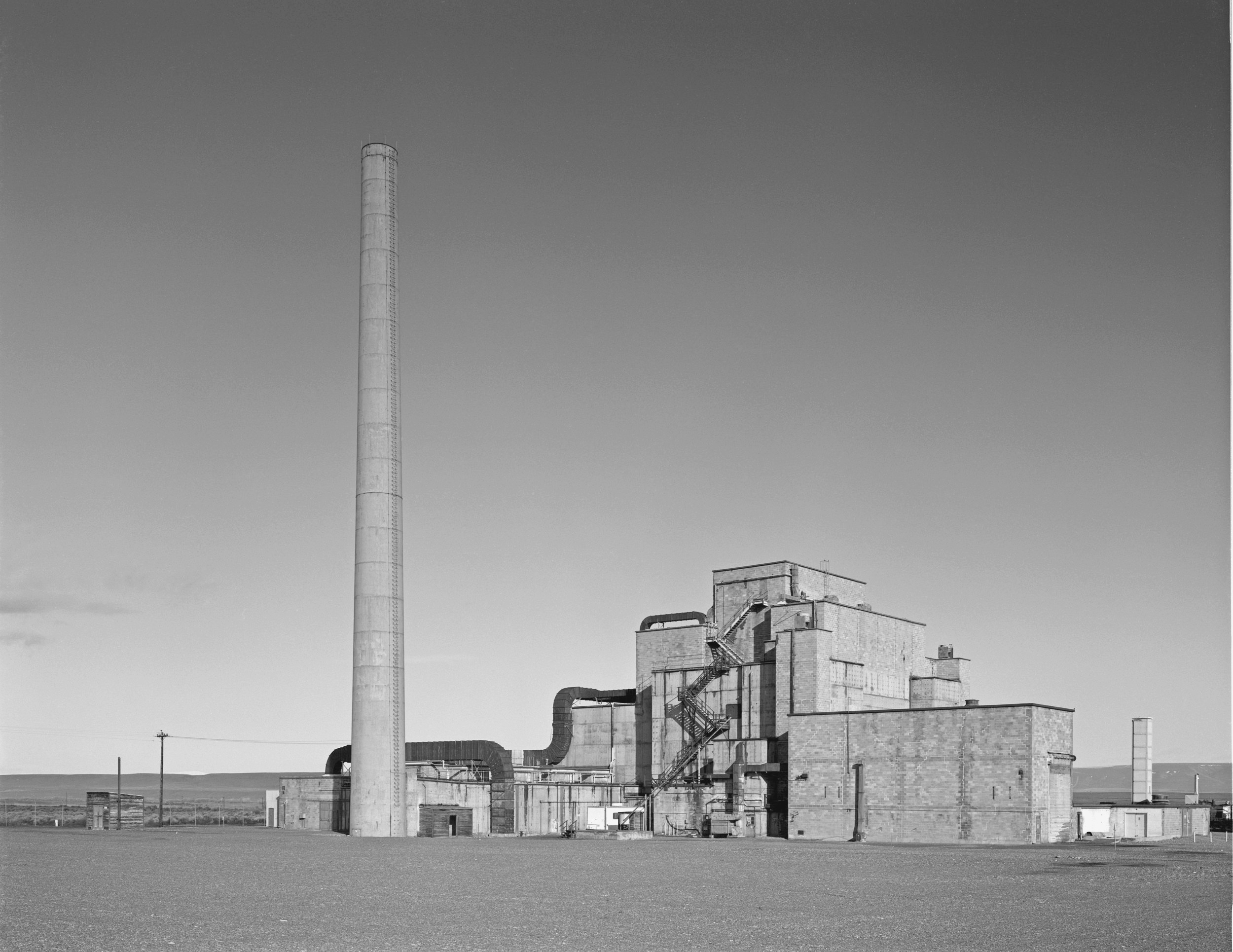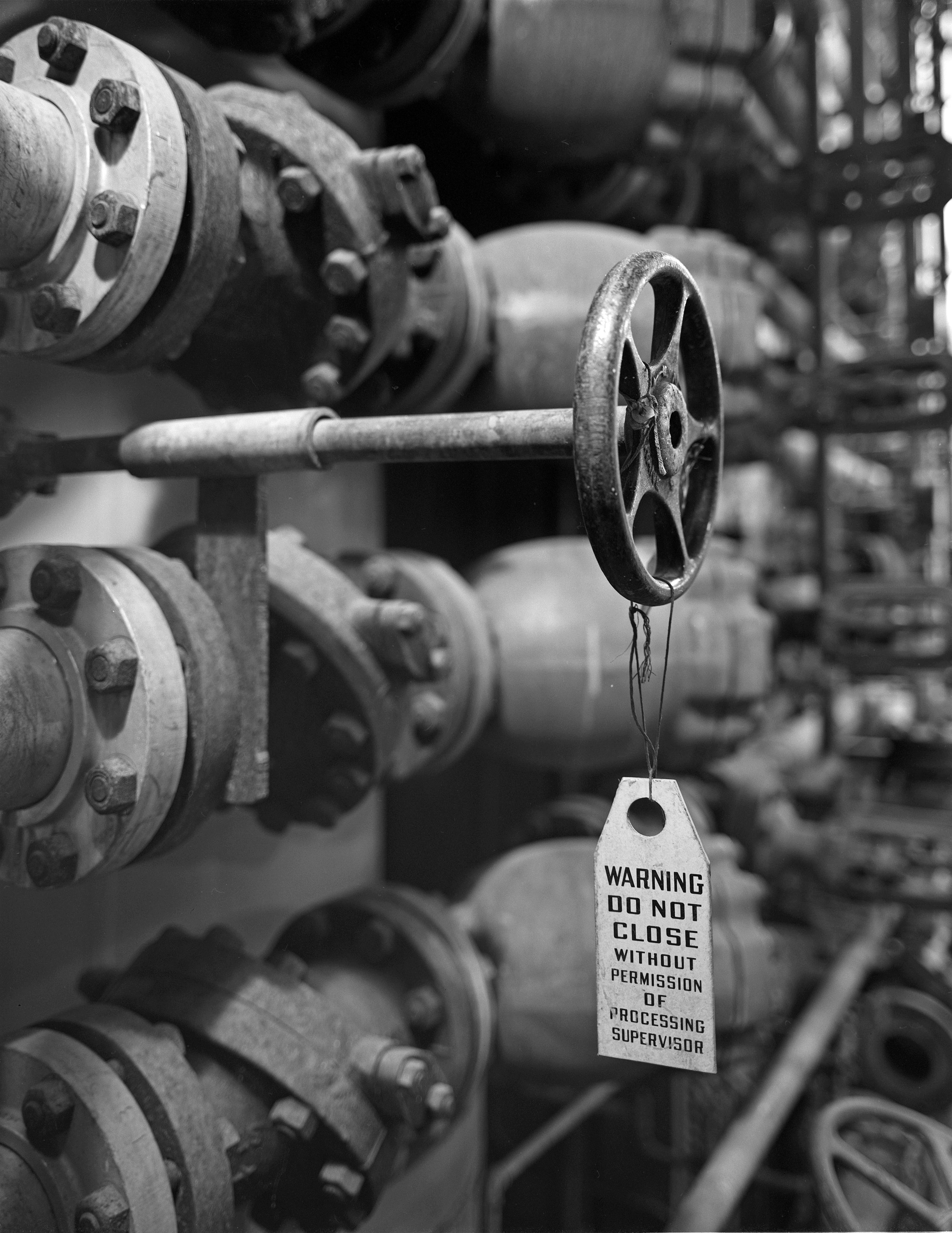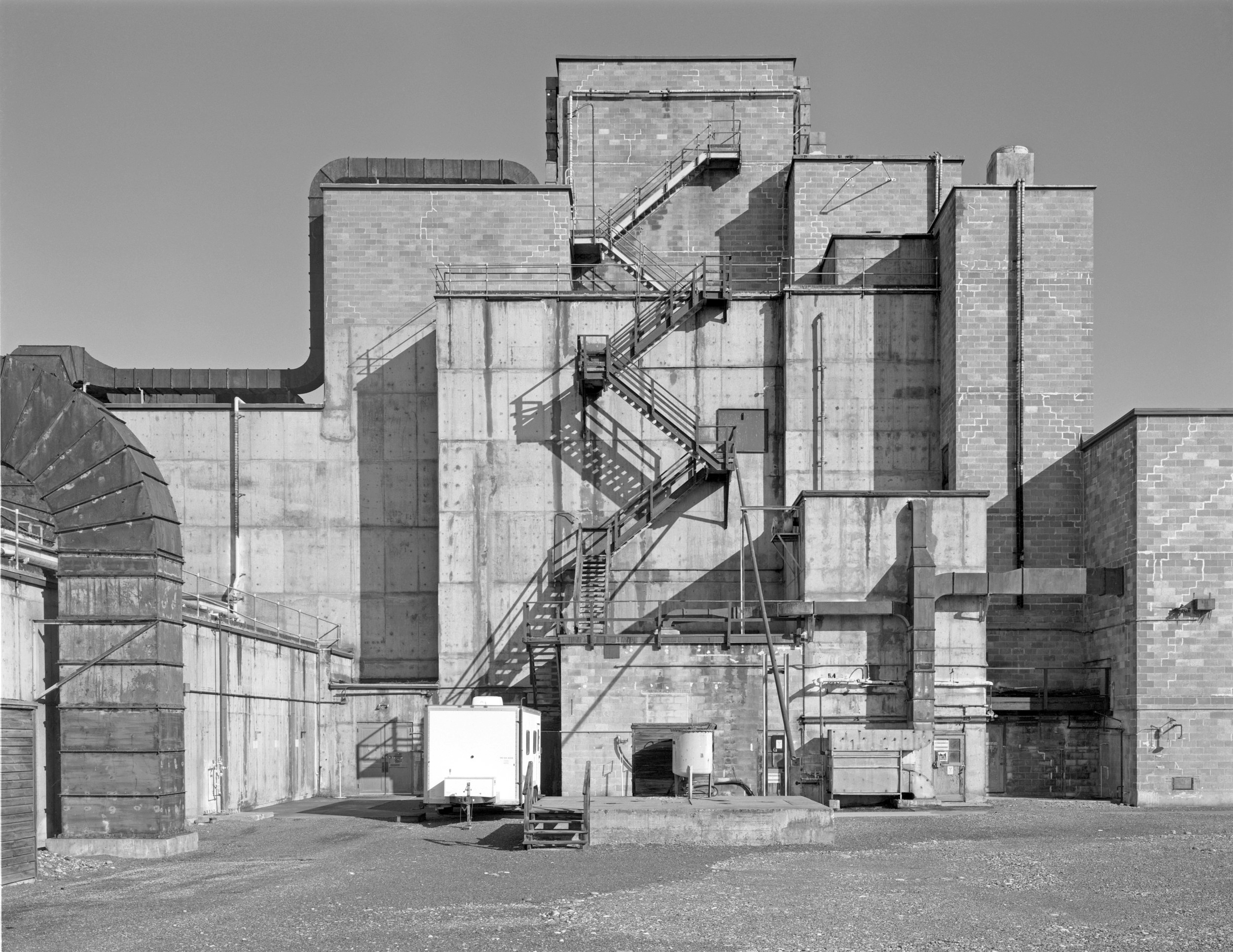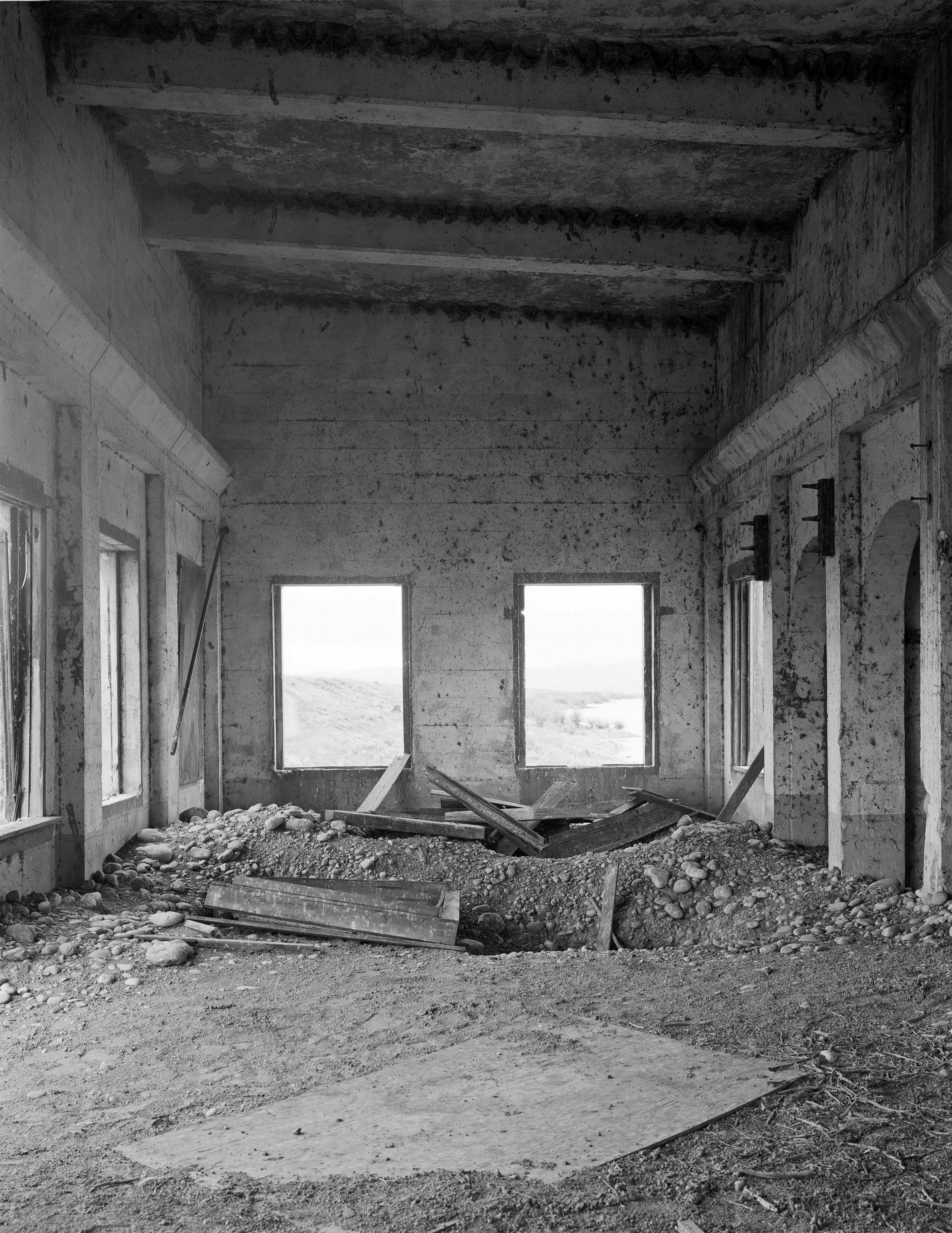
Manhattan Project Nat’l Historical Park, Washington (2017)
This is the loading face of B Reactor (1944), the world’s first full-scale nuclear reactor which produced the plutonium for the Trinity Test in Los Alamos, New Mexico and the Fat Man bomb dropped on Nagasaki, Japan.
4x5 silver gelatin

Manhattan Project Nat’l Historical Park, Washington (2017)
Looking northwest toward B Reactor.
4x5 silver gelatin

Manhattan Project Nat’l Historical Park, Washington (2017)
Looking north toward B Reactor from C Reactor.
4x5 silver gelatin

Manhattan Project Nat’l Historical Park, Washington (2017)
A broader view of the reactor operator's console and scram panel within the Control Room. This chair is an original. Today, a different chair is placed here during tour season.
Years ago, I was on a tour here and Dee McCullough, the reactor operator who was on duty the first night of operation, was acting as a docent. This chair was in place but had a rope across the arms. I was talking with Dee as the group moved on. He leaned over conspiratorially and asked, "Do you want to sit in it?" I said, "Is that permitted?" He said, "Well... it's my chair so I think I can decide!"
4x5 silver gelatin

Manhattan Project Nat’l Historical Park, Washington (2017)
This is the reactor operator's console inside B Reactor. The clocks have been set to the time when B Reactor went critical on September 26th, 1944, marking the world's first self-sustaining chain reaction.
4x5 silver gelatin

Manhattan Project Nat’l Historical Park, Washington (2017)
This wiring harness for the temperature monitoring equipment for B Reactor's bioshield, is hand-tied wax string. Circuits are hand-soldered. A Ray-o-Vac D-Cell supplies a constant flow of electricity to the circuitry.
4x5 silver gelatin

Manhattan Project Nat’l Historical Park, Washington (2017)
This console in the Control Room is part of the monitoring instrumentation.
4x5 silver gelatin

Manhattan Project Nat’l Historical Park, Washington (2017)
B Reactor (1944), the world's first full-scale nuclear reactor which made plutonium for the Trinity Test in Los Alamos, NM and the Fat Man Bomb dropped on Nagasaki, Japan sits at the 100B/C site in the northwest corner of the Hanford Reservation. Since the creation of the reservation, only 3% of the land has been disturbed with construction. The K-West and K-East Reactors are in the distance and the last free-flowing stretch of the Columbia River (i.e., water levels not influenced by dams).
4x5 silver gelatin

Manhattan Project Nat’l Historical Park, Washington (2017)
This is part of the Control Room within B Reactor. These Venturi valve gauges monitor cooling water across the 2,004 process tubes containing fissile uranium fuel slugs.
Don't cause a scram.
4x5 silver gelatin

Manhattan Project Nat’l Historical Park, Washington (2017)
Here a hand-painted, wooden warning tag prevents workers from closing a cooling system valve at the loading face of the reactor.
4x5 silver gelatin

Manhattan Project Nat’l Historical Park, Washington (2017)
The south side of B Reactor is referred to as the far side because it is opposite from the Control Room. The most critical walls, those around the reactor core, are reinforced, cast-in-place concrete. Other walls were constructed of concrete brick and block, which could be completed faster.
4x5 silver gelatin

Manhattan Project Nat’l Historical Park, Washington (2017)
Diesel oil tank at B Reactor.
4x5 silver gelatin

Manhattan Project Nat’l Historical Park, Washington (2017)
A detail of the exhaust stack and ductwork of B Reactor.
4x5 silver gelatin

Manhattan Project Nat’l Historical Park, Washington (2017)
An access door into the transfer and storage area on the far side of B Reactor and adjacent mechanical ductwork.
4x5 silver gelatin

Manhattan Project Nat’l Historical Park, Washington (2017)
Looking at the underside of the ballast tanks and the connection to the accumulators. 4x4 wood posts provide a "soft brake" if the ballast tanks were to crash down in an emergency. The system pumps are in the background.
4x5 silver gelatin

Manhattan Project Nat’l Historical Park (2017)
B Reactor with C Reactor (cocooned) on the horizon. The locomotive and rail cars, now on permanent display, were used to transport spent fuel from reactors to the 200 Area for processing and separation. The steel superstructure at the right of the frame is to allow for maintenance and removal of the reactor’s horizontal control rods.
This photograph was published in Atomic Heritage Foundation’s 2018 edition of “Guide to the Manhattan Project in Washington State."
4x5 silver gelatin

Manhattan Project Nat’l Historical Park, Washington (2017)
The vertical safety rods (VSR) are used to rapidly shut down the chain reaction in an emergency. The rods contain boron, a neutron absorbing material which "poisons" the chain reaction by robbing it of free neutrons. Each circular hopper contained a sixty foot long safety rod which, during operation, would be suspended by the cables up above the reactor core. In an emergency or a power outage they would drop by gravity into the reactor. The rods have articulated segments so that even if an earthquake shifted the graphite blocks of the core, they could still snake their way down. Piping on the far wall was part of a last ditch safety system, tanks (no longer extant) filled with liquid boron solution which could be poured down the VSR channels. Wet graphite would make the reactor useless so, a few years after B Reactor began operating, the liquid boron system was replaced with the "Ball-X" system, spheres of boron encased in nickel. These could also pour down the VSR channels but be vacuumed out later. At the left in front of the short stair is one of the vacuums--it looks like a rocket.
4x5 silver gelatin

Manhattan Project Nat’l Historical Park, Washington (2017)
The Bruggemann Warehouse on the Hanford Reservation. This was abandoned with the creation of the reservation. West and south façades shown.
4x5 silver gelatin

Manhattan Project Nat’l Historical Park, Washington (2017)
The Bruggemann Warehouse on the Hanford Reservation. This was abandoned with the creation of the reservation. This view is looking north inside the main storage space. Three pairs of carriage doors face east.
4x5 silver gelatin

Manhattan Project Nat’l Historical Park, Washington (2017)
The Bruggemann Warehouse on the Hanford Reservation. This was abandoned with the creation of the reservation. This view is looking at the east façade and its carriage doors from the window another room.
4x5 silver gelatin

Manhattan Project Nat’l Historical Park, Washington (2017)
The Allard Pump House on what is now the Hanford Reservation supplied Columbia River water to the towns of Hanford and White Bluffs and irrigated thousands of acres of farmland. Fill has been added on the south side of the building. Originally, the building as surrounded by water and access was from the bank via bridge.
4x5 silver gelatin

Manhattan Project Nat’l Historical Park, Washington (2017)
4x5 silver gelatin

Manhattan Project Nat’l Historical Park, Washington (2017)
Hanford High School, abandoned with the creation of the Hanford Nuclear Reservation. Little else exists of the town of Hanford, Washington.
4x5 silver gelatin

Manhattan Project Nat’l Historical Park, Washington (2017)
Once the site of a major railroad station, these ties are the only reminder at White Bluffs.
4x5 silver gelatin

Manhattan Project Nat’l Historical Park, Washington (2017)
The White Bluffs Bank, currently under restoration. This is the only building remaining at the abandoned town of White Bluffs, evacuated for the creation of the Hanford Reservation. The block building still contains its safe. The existing wooden window frames and sashes, thanks to the desiccating climate, were mostly salvageable and were repaired and reglazed.
4x5 silver gelatin

Manhattan Project Nat’l Historical Park, Washington (2017)
The White Bluffs Bank, currently under restoration, is the only building remaining at the abandoned town of White Bluffs, evacuated for the creation of the Hanford Reservation. Note the hand-painted sign, added after the bank was no longer in use, is being preserved in situ. It warns Hanford workers to "inspect, detect, and correct fire hazards," a serious problem at abandoned townsites.
4x5 silver gelatin


























Manhattan Project Nat’l Historical Park, Washington (2017)
This is the loading face of B Reactor (1944), the world’s first full-scale nuclear reactor which produced the plutonium for the Trinity Test in Los Alamos, New Mexico and the Fat Man bomb dropped on Nagasaki, Japan.
4x5 silver gelatin
Manhattan Project Nat’l Historical Park, Washington (2017)
Looking northwest toward B Reactor.
4x5 silver gelatin
Manhattan Project Nat’l Historical Park, Washington (2017)
Looking north toward B Reactor from C Reactor.
4x5 silver gelatin
Manhattan Project Nat’l Historical Park, Washington (2017)
A broader view of the reactor operator's console and scram panel within the Control Room. This chair is an original. Today, a different chair is placed here during tour season.
Years ago, I was on a tour here and Dee McCullough, the reactor operator who was on duty the first night of operation, was acting as a docent. This chair was in place but had a rope across the arms. I was talking with Dee as the group moved on. He leaned over conspiratorially and asked, "Do you want to sit in it?" I said, "Is that permitted?" He said, "Well... it's my chair so I think I can decide!"
4x5 silver gelatin
Manhattan Project Nat’l Historical Park, Washington (2017)
This is the reactor operator's console inside B Reactor. The clocks have been set to the time when B Reactor went critical on September 26th, 1944, marking the world's first self-sustaining chain reaction.
4x5 silver gelatin
Manhattan Project Nat’l Historical Park, Washington (2017)
This wiring harness for the temperature monitoring equipment for B Reactor's bioshield, is hand-tied wax string. Circuits are hand-soldered. A Ray-o-Vac D-Cell supplies a constant flow of electricity to the circuitry.
4x5 silver gelatin
Manhattan Project Nat’l Historical Park, Washington (2017)
This console in the Control Room is part of the monitoring instrumentation.
4x5 silver gelatin
Manhattan Project Nat’l Historical Park, Washington (2017)
B Reactor (1944), the world's first full-scale nuclear reactor which made plutonium for the Trinity Test in Los Alamos, NM and the Fat Man Bomb dropped on Nagasaki, Japan sits at the 100B/C site in the northwest corner of the Hanford Reservation. Since the creation of the reservation, only 3% of the land has been disturbed with construction. The K-West and K-East Reactors are in the distance and the last free-flowing stretch of the Columbia River (i.e., water levels not influenced by dams).
4x5 silver gelatin
Manhattan Project Nat’l Historical Park, Washington (2017)
This is part of the Control Room within B Reactor. These Venturi valve gauges monitor cooling water across the 2,004 process tubes containing fissile uranium fuel slugs.
Don't cause a scram.
4x5 silver gelatin
Manhattan Project Nat’l Historical Park, Washington (2017)
Here a hand-painted, wooden warning tag prevents workers from closing a cooling system valve at the loading face of the reactor.
4x5 silver gelatin
Manhattan Project Nat’l Historical Park, Washington (2017)
The south side of B Reactor is referred to as the far side because it is opposite from the Control Room. The most critical walls, those around the reactor core, are reinforced, cast-in-place concrete. Other walls were constructed of concrete brick and block, which could be completed faster.
4x5 silver gelatin
Manhattan Project Nat’l Historical Park, Washington (2017)
Diesel oil tank at B Reactor.
4x5 silver gelatin
Manhattan Project Nat’l Historical Park, Washington (2017)
A detail of the exhaust stack and ductwork of B Reactor.
4x5 silver gelatin
Manhattan Project Nat’l Historical Park, Washington (2017)
An access door into the transfer and storage area on the far side of B Reactor and adjacent mechanical ductwork.
4x5 silver gelatin
Manhattan Project Nat’l Historical Park, Washington (2017)
Looking at the underside of the ballast tanks and the connection to the accumulators. 4x4 wood posts provide a "soft brake" if the ballast tanks were to crash down in an emergency. The system pumps are in the background.
4x5 silver gelatin
Manhattan Project Nat’l Historical Park (2017)
B Reactor with C Reactor (cocooned) on the horizon. The locomotive and rail cars, now on permanent display, were used to transport spent fuel from reactors to the 200 Area for processing and separation. The steel superstructure at the right of the frame is to allow for maintenance and removal of the reactor’s horizontal control rods.
This photograph was published in Atomic Heritage Foundation’s 2018 edition of “Guide to the Manhattan Project in Washington State."
4x5 silver gelatin
Manhattan Project Nat’l Historical Park, Washington (2017)
The vertical safety rods (VSR) are used to rapidly shut down the chain reaction in an emergency. The rods contain boron, a neutron absorbing material which "poisons" the chain reaction by robbing it of free neutrons. Each circular hopper contained a sixty foot long safety rod which, during operation, would be suspended by the cables up above the reactor core. In an emergency or a power outage they would drop by gravity into the reactor. The rods have articulated segments so that even if an earthquake shifted the graphite blocks of the core, they could still snake their way down. Piping on the far wall was part of a last ditch safety system, tanks (no longer extant) filled with liquid boron solution which could be poured down the VSR channels. Wet graphite would make the reactor useless so, a few years after B Reactor began operating, the liquid boron system was replaced with the "Ball-X" system, spheres of boron encased in nickel. These could also pour down the VSR channels but be vacuumed out later. At the left in front of the short stair is one of the vacuums--it looks like a rocket.
4x5 silver gelatin
Manhattan Project Nat’l Historical Park, Washington (2017)
The Bruggemann Warehouse on the Hanford Reservation. This was abandoned with the creation of the reservation. West and south façades shown.
4x5 silver gelatin
Manhattan Project Nat’l Historical Park, Washington (2017)
The Bruggemann Warehouse on the Hanford Reservation. This was abandoned with the creation of the reservation. This view is looking north inside the main storage space. Three pairs of carriage doors face east.
4x5 silver gelatin
Manhattan Project Nat’l Historical Park, Washington (2017)
The Bruggemann Warehouse on the Hanford Reservation. This was abandoned with the creation of the reservation. This view is looking at the east façade and its carriage doors from the window another room.
4x5 silver gelatin
Manhattan Project Nat’l Historical Park, Washington (2017)
The Allard Pump House on what is now the Hanford Reservation supplied Columbia River water to the towns of Hanford and White Bluffs and irrigated thousands of acres of farmland. Fill has been added on the south side of the building. Originally, the building as surrounded by water and access was from the bank via bridge.
4x5 silver gelatin
Manhattan Project Nat’l Historical Park, Washington (2017)
4x5 silver gelatin
Manhattan Project Nat’l Historical Park, Washington (2017)
Hanford High School, abandoned with the creation of the Hanford Nuclear Reservation. Little else exists of the town of Hanford, Washington.
4x5 silver gelatin
Manhattan Project Nat’l Historical Park, Washington (2017)
Once the site of a major railroad station, these ties are the only reminder at White Bluffs.
4x5 silver gelatin
Manhattan Project Nat’l Historical Park, Washington (2017)
The White Bluffs Bank, currently under restoration. This is the only building remaining at the abandoned town of White Bluffs, evacuated for the creation of the Hanford Reservation. The block building still contains its safe. The existing wooden window frames and sashes, thanks to the desiccating climate, were mostly salvageable and were repaired and reglazed.
4x5 silver gelatin
Manhattan Project Nat’l Historical Park, Washington (2017)
The White Bluffs Bank, currently under restoration, is the only building remaining at the abandoned town of White Bluffs, evacuated for the creation of the Hanford Reservation. Note the hand-painted sign, added after the bank was no longer in use, is being preserved in situ. It warns Hanford workers to "inspect, detect, and correct fire hazards," a serious problem at abandoned townsites.
4x5 silver gelatin